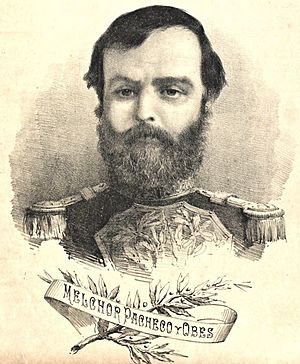Melchor Pacheco y Obes facts for kids
Quick facts for kids
Melchor Pacheco y Obes
|
|
|---|---|
 |
|
| Born | 20 January 1809 Buenos Aires, Viceroyalty of the Río de la Plata |
| Died | 21 May 1855 (aged 46) Buenos Aires, Argentina |
| Allegiance | |
| Service/ |
|
| Rank | General |
| Battles/wars | Cisplatine War
Uruguayan Civil War
|
| Spouse(s) | Manuela Texera Matilde Stewart Aguell |
Melchor Pacheco y Obes (born January 20, 1809, died May 21, 1855) was an important military leader and politician. He played a big role in the history of what we now call Uruguay. He belonged to the Colorado Party. He was a key figure in the "Government of Defense" in Montevideo during the Uruguayan Civil War.
Contents
Melchor Pacheco y Obes: A Life in Uruguay's History
Early Life and First Battles
Melchor Pacheco y Obes was born in Buenos Aires. His father, Jorge Pacheco, was a captain. Melchor studied in Buenos Aires and Rio de Janeiro. When he was 16, in 1825, he joined a rebel group. This group was fighting against Brazil to free the region known as the Banda Oriental.
He fought in the Battle of Ituzaingó in February 1827. After this, he moved to Montevideo, Uruguay. He became friends with Juan Antonio Lavalleja. However, he did not join Lavalleja's revolt in 1832. Instead, he fought against him. He also stayed out of other political uprisings at that time.
The Uruguayan Civil War and His Rise to Power
In February 1839, a new war began. This was the Uruguayan Civil War (1839-1851). Pacheco joined the army and quickly moved up in rank. By 1841, he was a lieutenant colonel. He was known for his good education and strong leadership skills.
After a major battle in December 1842, Pacheco became the Minister of War and Navy. Montevideo was under attack, and Pacheco became a hero. He was an amazing organizer. He brought in General José María Paz to help lead the army. He also rebuilt and made the city's defenses stronger. Pacheco became the main person defending Montevideo. He fought in important battles and became very famous.
In 1844, he had a disagreement with the government. He resigned and was sent away to Rio de Janeiro. But in 1845, he was called back by President Joaquín Suárez. He was made a general and given full command of the troops defending Montevideo.
Diplomatic Missions and Final Years
In 1849, Pacheco became a special ambassador for Uruguay in France. His goal was to convince the French government to keep supporting Uruguay's defense. He gave a powerful speech to the French Parliament. He spoke fluent French and strongly argued for his country. He even told off some deputies who were not paying attention. He said, "In our wars we die, gentlemen. Is it that something else happens in yours?"
Even though he made a great impression, he did not get direct help. However, he became friends with famous writer Alexandre Dumas (the father). It is believed that Pacheco wrote a book called Montevideo or the New Troy, and Dumas just signed it.
After the Uruguayan Civil War ended in 1851, Pacheco returned to Uruguay. He joined the conservative part of the Colorado Party. In 1853, he was involved in a military uprising known as "Pacheco's Mutiny." This event led to the resignation of President Juan Francisco Giró. Pacheco became the Chief of the Army General Staff. This gave him a lot of military power.
However, another leader named Venancio Flores became very powerful. Pacheco did not get along with him and resigned. He worked as a newspaper editor for a few months. In May 1854, he left Uruguay and moved to Buenos Aires. He died there on May 21, 1855. His body was later brought back to Montevideo. He is buried in the National Pantheon. Pacheco y Obes was known more as an organizer, speaker, and journalist than just a soldier.
See also
 In Spanish: Melchor Pacheco y Obes para niños
In Spanish: Melchor Pacheco y Obes para niños

